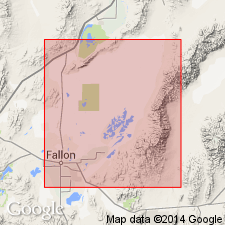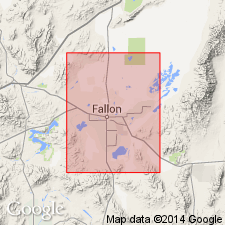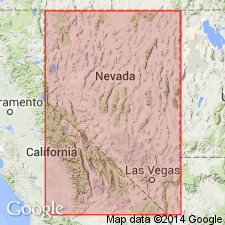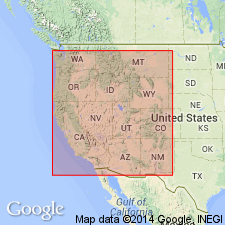
- Usage in publication:
-
- Lahontan Valley group*
- Modifications:
-
- Named
- Dominant lithology:
-
- Alluvium
- Sand
- Gravel
- AAPG geologic province:
-
- Great Basin province
Summary:
Named after Lahontan Valley, its type area in southern Carson Desert near Fallon, Churchill Co, NV. Consists of lacustrine sediments deposited in Lake Lahontan and interfingering and immediately overlying subaerial sediments. Divided into five formations on basis of lithologic differences due to two major alternations from mainly deep-lake to subaerial and shallow-lake sediments (ascending); Eetza, Wyemaha, Sehoo, Indian Lakes, and Turupah formations (all new). Overlies Paiute formation (new); underlies Fallon formation (new). Age given as late Pleistocene.
Source: GNU records (USGS DDS-6; Menlo GNULEX).

- Usage in publication:
-
- Lahontan Valley group*
- Modifications:
-
- Overview
- AAPG geologic province:
-
- Great Basin province
Summary:
Detailed descriptions of formations within Lahontan Valley group, lists of fossils, stratigraphic sections included in report. Shown on geologic maps of Stillwater, Fallon, and Carson Lake 15' quads. Age given as Pleistocene.
Source: GNU records (USGS DDS-6; Menlo GNULEX).

- Usage in publication:
-
- Lahontan Valley Group
- Modifications:
-
- Revised
- AAPG geologic province:
-
- Great Basin province
Summary:
Lahontan Valley Group divided into six formations (ascending): Eetza (lacustrine), S Bar S (subaerial) (new), Wyemaha (subaerial and very shallow lake), Sehoo (lacustrine), Indian Lakes (subaerial), and Turupah (subaerial) Formations. S Bar S Formation named and described in Truckee River valley in this paper.
Source: GNU records (USGS DDS-6; Menlo GNULEX).

- Usage in publication:
-
- Lahontan Valley Group*
- Modifications:
-
- Age modified
- AAPG geologic province:
-
- Great Basin province
Summary:
Correlation chart shows age of Lahontan Valley Group to be Pleistocene and Holocene on basis of radiometric ages of Morrison and Frye (1965), Broecker and Kaufman (1965), and R.B. Morrison (written commun., 1970).
Source: GNU records (USGS DDS-6; Menlo GNULEX).
For more information, please contact Nancy Stamm, Geologic Names Committee Secretary.
Asterisk (*) indicates published by U.S. Geological Survey authors.
"No current usage" (†) implies that a name has been abandoned or has fallen into disuse. Former usage and, if known, replacement name given in parentheses ( ).
Slash (/) indicates name conflicts with nomenclatural guidelines (CSN, 1933; ACSN, 1961, 1970; NACSN, 1983, 2005, 2021). May be explained within brackets ([ ]).

